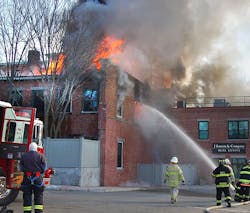A post-fire report was released this week that describes the problems experienced by the Gloucester, MA Fire Department when attempting to fight a fire last March in a two-story, downtown, commercial building—and the conclusions aren’t pretty.
The city-commissioned report prepared by Municipal Resources, Inc., describes how first arriving companies found a working fire in a law office on the first floor of a two story ordinary construction building, how they attacked the fire and knocked it down, vented the roof, set up a PPV fan, and then executed a shift change, sending all but one engine back to quarters. In the meantime, people in the street noticed an increase in smoke issuing from the building and the tenant of an attached exposure building reported increasing smoke build up in his occupancy as well.
Gloucester and mutual aid companies, summoned back to the scene about half an hour after they were released, found fire through the roof of the original fire building and extending into the occupancy.
Well, this could have happened to any of us, but the report goes on to say that the ceiling and sidewall areas were not opened up during the original overhaul and the dependence on just thermal imaging cameras to spot suspected areas of involvement allowed the fire to spread undetected, pushed by the PPV fan.
The link to the Gloucester report is here: http://www.publicgloucester.com/docs/PleasantStreetFireReport.pdfWhile analyzing the report and its recommendations will provide the basis for an eye-opening drill for all of us, the problems remaining in Gloucester go much further.
One of the primary recommendations of the report is that the department members need more training. Less than half are certified to NFPA Firefighter I/II standards, although to be fair, there is no requirement in the state for firefighters employed before the requirement for new hires was enacted.
The report also cited that there is no full-time training officer and training within the department is “sporadic.”
The most damning conclusion was that the investigation found that the Gloucester command staff and responding firefighters failed to follow “best practices” for fighting the fire, including following National Incident Management System guidelines.
While we labor under the assumption that the department failed here, and they do share some of the blame, there is also another side to the story.
In December of 2007, the department responded to a fire in a wood frame apartment building, the result of which was that a life was lost, numerous firefighters injured and two buildings destroyed.
It is ironic now that after that fire, Mayor Carolyn Kirk, who is still in office, commissioned an investigative report from Municipal Resources, Inc. And, guess what. The report released in 2009, stated that the fire spread because of, “Inability to execute the tactics and functions required based on limited training.”
There were more recommendations as well such as implementing NIMS and ICS training for all members, developing a comprehensive set of SOPs and SOGs, establish predetermined RIT crews that respond automatically, upgrade the dispatch, communication and phone recording capabilities, and encourage members to attend National Fire Academy courses for the Command and Control of Multiple Alarm Incidents.
The link to the 2009 Gloucester report is here: http://gloucester-ma.gov/DocumentView.aspx?DID=753Unfortunately, many of these recommendations were not implemented and are once again cited in a report written just 2 years later.
The Mayor is now proposing to aggressively fund and make sure the department is brought up to snuff, but that’s what she promised in 2009. Newspaper stories and interviews with citizens indicate that there seems to have been funding problems, and much finger-pointing between fire officials, city officials and union officials as to who was responsible for implementing the recommendations of the 2009 report.
The next chapter in this saga, hopefully, will describe the initiatives taken to further train the firefighters, fund a training officer position, upgrade their dispatch capabilities and provide their leadership with the tools to properly command an incident.
Be sure to read the reports and think about the implications contained within if this was your department. There is much to learn.
Photo by Jay Albert






